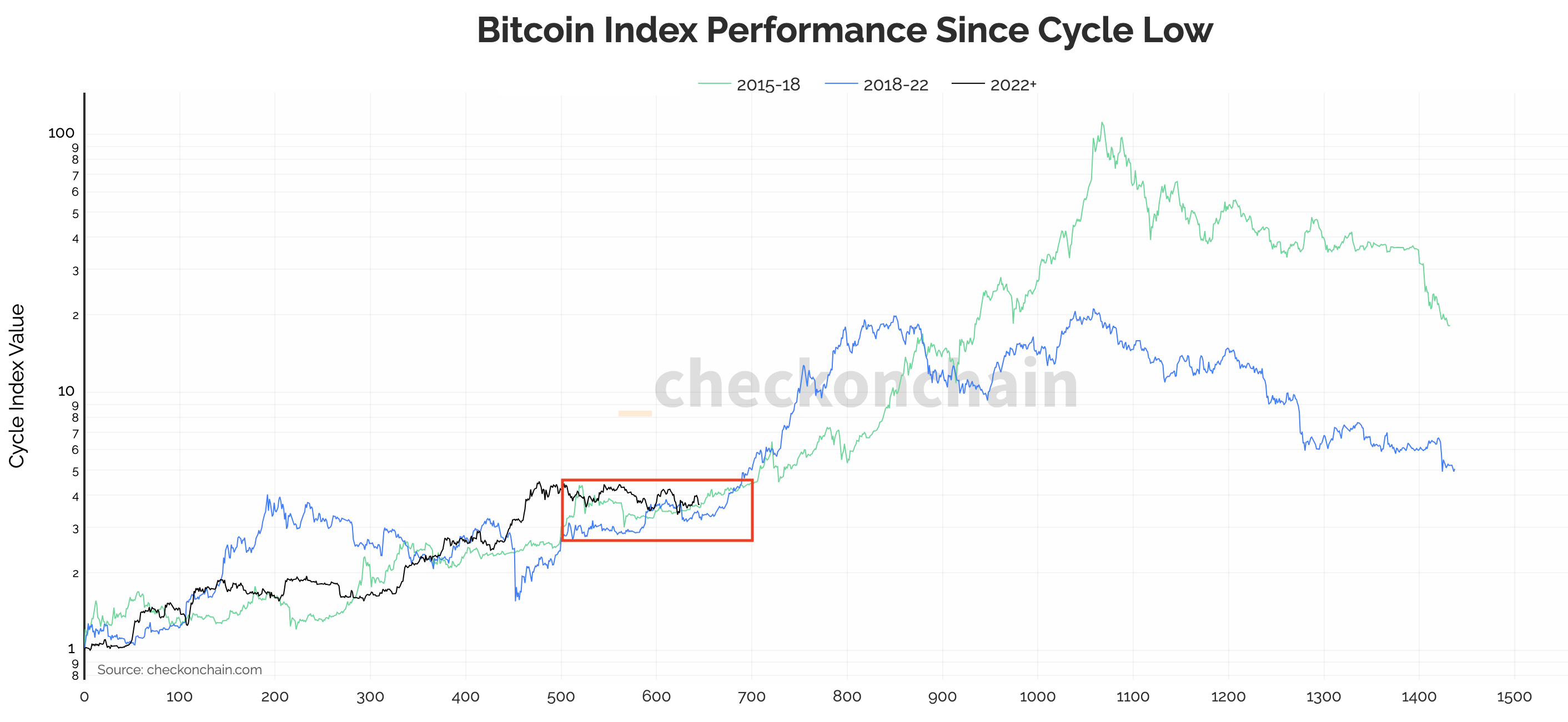The Bumps in This Bull Market

28 August 2024
On August 5, the crypto market unexpectedly experienced a sharp decline. That turmoil is now two weeks in the rearview mirror, and bitcoin's price has been moving sideways around $59,000. Altcoins have been hit hardest by this status quo. What's our outlook on this? Find out more in this Weekly!
This weekly in brief:
- Market: Following Powell’s remarks last Friday, Bitcoin surged to $65,000, but that gain was reversed yesterday.
- News: In recent days, the news has been dominated by the arrest of Telegram CEO Pavel Durov. His arrest has also caused a stir in the crypto world, with the TON price dropping 21% in just a few days.
Market Update
De koers van bitcoin noteert vandaag 59.000 dollar, hetzelfde bedrag als zeven, veertien en twintig dagen geleden. Het grootste deel van de maand augustus brachten we tussen de 58.000 dollar en 62.000 dollar door, met twee opvallende uitstapjes.
Het eerste uitstapje is de felle daling naar 49.000 dollar op 5 augustus. Die dag was er iets bijzonders aan de hand op de financiële markten, aangedreven door snelle bewegingen van de rente in Japan en de wisselkoers van de Japanse yen. Een tijdelijke afwijking. Koersen herstelden snel, op 8 augustus stonden er alweer koersen boven de 61.000 dollar op de borden.
Het tweede uitstapje is de stijging van het afgelopen weekend. Al een paar weken worstelde de markt met de zone tussen de 61.000 dollar en 64.000 dollar. Daar liggen het 50-daagse en het 200-daagse gemiddelde, maar ook de gemiddelde aankoopkoers van recent ingestapte beleggers.
Het 50-daagse gemiddelde is dominant. Onderstaande grafiek laat zien hoe de koers met dit gemiddelde flirtte. Vijf pogingen om erdoorheen te breken mislukten. De zesde slaagde, en lijkt een reactie op de toespraak van Jerome Powell, de voorzitter van de Amerikaanse centrale bank. Hij vindt dat de tijd rijp is voor renteverlagingen.
De stijging naar 65.000 dollar op vrijdagavond werd op dinsdag weer ongedaan gemaakt door een even zo ruwe daling. En zo zijn we terug op 59.000 dollar. Kijkend naar de korte termijn is de richtingloosheid wellicht wat frustrerend. Maar met een iets wijdere blik ziet het er helemaal niet slecht uit. We zitten immers 125% boven de koers van 12 maanden geleden, toen we nog tegen koersen rond 26.000 dollar aankeken.

We often hear concerns about the absence of a new upward trend. After the ETFs and the halving, wasn’t the price supposed to explode? Some influencers were talking about ‘omega candles’ and a rapid rise to a million dollars per Bitcoin.
Every bull market has its bumps. And every bull market has its unique bumps. The launch of Bitcoin ETFs was a spike upwards, while the tens of thousands of Bitcoins released onto the market by the German government and the Mt.Gox trustees were a spike downwards.
However, when you compare this market cycle with the previous two, it’s clear that we’re actually in the same place. The chart below shows the rise from the bottom of the market cycle. November 2022, December 2018, and January 2015 were overlaid by analyst James Check as starting points.
The red marking represents a 200-day period, from 500 to 700 days after the bear market bottom. Looking at it this way, we might have gotten ahead of ourselves in this bull market, and the long correction since March has given the previous two cycles a chance to catch up.
This comparison doesn’t have predictive value but does show that where we stand in this bull market isn’t unusual or drastically different from the previous two bull markets. If it’s anything like the last two times, we might need just one to two more months of patience!

News Overview
In the 1990s, Stratton Oakmont, the investment firm later made famous by The Wolf of Wall Street, fought a legal battle with the online platform Prodigy. The court ruled that Prodigy was liable for defamatory posts on its forum because it had moderated some of the content. This decision created a strange incentive: platforms would be better off not moderating at all to avoid liability. This led to the creation of Section 230, also known as "the 26 words that created the internet," which established that platforms are not liable for the content users post.
But Section 230 wasn't just a random creation. Chris Cox and Ron Wyden, two forward-thinking members of Congress, wanted to establish a legal framework where internet companies could thrive without getting entangled in endless lawsuits over user-generated content. Their proposal was initially overlooked, but it turned out to be the backbone of the modern internet. Companies like Facebook and Twitter were able to grow into global giants because of it.
Fast forward to August 2024. Pavel Durov, the enigmatic and often admired founder of Telegram, is suddenly arrested in France. His platform, once praised for its strong privacy measures, is now under fire because French authorities believe it does too little to prevent criminal activity. Here, fundamental values clash: freedom of speech and privacy are at odds with the need to combat crime and prevent the misuse of technology.
The Durov case is currently difficult to grasp, not least because all the facts are not yet known. That hasn't stopped users on X from expressing strong opinions, many of which come from the crypto community. They view Durov's arrest as a targeted attack on personal freedoms, while the French authorities appear to be concerned with Telegram's failure to act against criminal behavior.
This arrest is also impacting the crypto world through Telegram itself. Not only is the platform home to countless crypto projects, but it is also deeply integrated with The Open Network (TON, formerly Telegram Open Network), making it a participant in the crypto economy. Is Durov's arrest a risk for investors in TON, the network's native cryptocurrency? What about the projects built on it? And how will the developers who work on it fare now that they are missing their leader?
The market has translated this tension into a significant drop in TON's price. Since Durov's arrest, the value has fallen by 21% to $5.32. The situation wasn't helped by the blockchain platform experiencing a seven-hour outage last night. Binance and Bybit suspended trading of the coin, and concerns about the network's continuity spread across social media.
However, these worries quickly faded into the background. Why? In the end, the issues turned out to be related to the distribution of – yes – a memecoin.
💡 MATIC becomes POL
On September 4, 2024, Polygon will implement an upgrade where the current MATIC token will be replaced by POL. Do you own MATIC? We will provide a cost-free 1-to-1 migration, with no impact on price or staking rewards.
On September 3 at 12:00, we will pause trading, staking, deposits, and withdrawals of MATIC. All functionalities will be re-enabled on September 6 at 12:00. If available earlier, you will see this in the app or web platform.

Other news:
- Sony Launches Its Own Layer 2 Network Soneium. On Friday, Sony announced the existence of its new project, Soneium, in a press release. Soneium is a rollup on Ethereum designed as a "versatile, general-purpose blockchain." Sony plans to develop new services that integrate with existing Sony products such as Sony Bank, Sony Music, and Sony Pictures. While the exact plans remain unclear, expectations are running high.
- Fund Managers Withdraw Applications for Spot Solana ETF.
According to sources from The Block, the SEC has rejected applications for a spot Solana ETF on the grounds that Solana (SOL) is considered a security. There are no established regulations to support this claim, and no court has yet ruled on SOL's status. Two fund managers still have active applications pending, but it is expected that they will also withdraw. - MakerDAO Adopts New Identity: Sky. The popular stablecoin DAI is set to be exchanged for the stablecoin USDS, and the governance token will also undergo changes. After the rebranding takes effect on September 18, the new ecosystem will be managed by the organization Skybase International. The reason behind this new identity is unclear, but increased regulatory pressure may be a factor. Unlike DAI, USDS has a built-in function to freeze funds, and the Sky website blocks the use of VPNs.

Our website uses cookies
We use cookies to personalize content and advertisements, to offer social media features and to analyze our website’s traffic. We’ll also share information about your usage with our partners for social media, advertising and analysis. These partners can combine this data with data you’ve already provided to them, or that they’ve collected based on your use of their services.